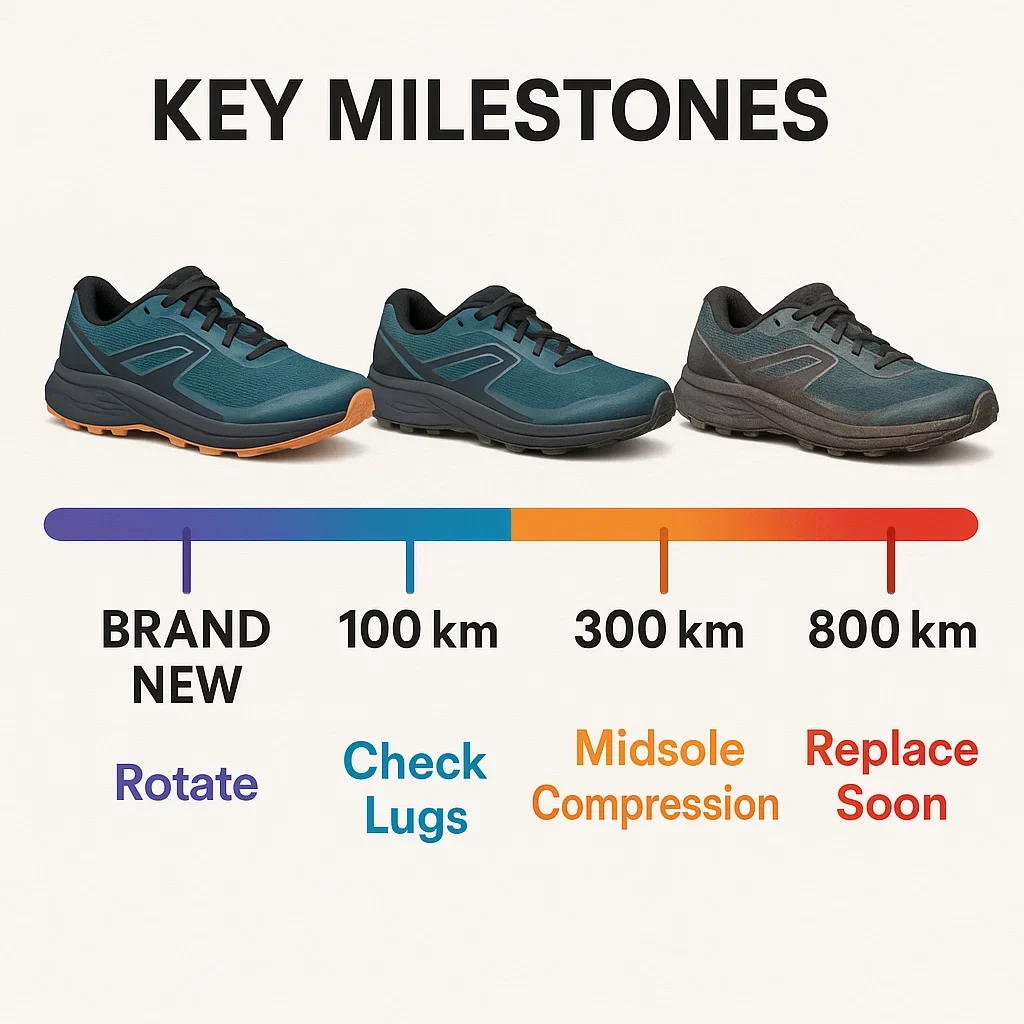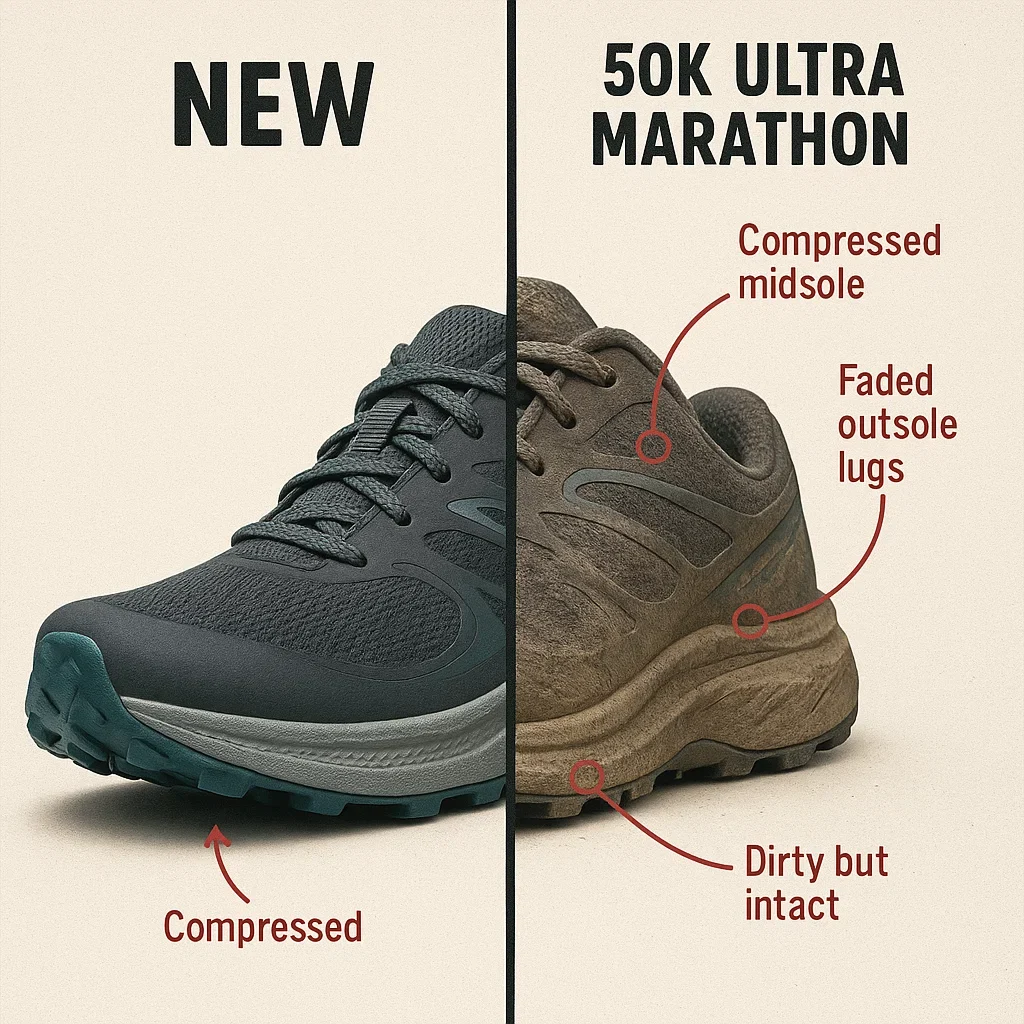How long will your trail running shoes survive a 50K ultra marathon—and how can you make them last longer?
Welcome to the most detailed durability & mileage guide for ultra runners! Dive into real-world tests, expert tips, mileage tables, maintenance hacks, runner case studies, and everything you need to get more kilometers for your money.
- Cost efficiency: Durable shoes mean fewer replacements = money saved.
- Injury prevention: Worn-out midsoles and outsoles increase risk of slips, falls, and overuse injuries.
- Performance: Fresh shoes deliver optimal grip, cushion, and confidence—worn shoes lose energy return and stability.
- Race day: Nobody wants their shoes to “die” at kilometer 38—know your pair’s real lifespan!
🏷️ Trail Shoe Mileage Table: How Long Do Top Brands Last?
| Brand/Model | Typical Mileage | Main Weakness | Best Use |
|---|---|---|---|
| Hoka Speedgoat | 400–600 km | Midsole compression | Mountain ultras, rocky terrain |
| Salomon Sense Ride | 500–700 km | Outsole wear | Mixed trail, technical races |
| Altra Lone Peak | 400–600 km | Upper tearing | Wide-foot, dry conditions |
| Brooks Cascadia | 600–900 km | Grip fades | All-rounder, long trail |
| La Sportiva Bushido II | 600–800 km | Forefoot lugs wear down | Technical, alpine, mud |
| Inov-8 Trailfly G 270 | 700–900 km | Heel cup breakdown | Fast 50K, minimal feel |
| Merrell MTL Long Sky 2 | 500–800 km | Upper splits | Mixed trail, wet races |
- Midsole: Press the foam—if it doesn’t spring back, it’s “dead.”
- Outsole: Are lugs worn smooth, especially at the heel and forefoot?
- Upper: Any tears, holes, or loose stitching?
- Fit: Do shoes feel sloppy, wider, or less supportive than before?
- Cushion: Do you feel every rock or root on the trail?
- Do you mostly run on rocky/technical or soft/forest trails?
- Are you a forefoot striker, heel striker, or midfoot?
- Do you rotate 2+ pairs, or use just one shoe at a time?
- Is your weekly mileage over 60km?
- Have you ever run a shoe “to destruction” in a single race?
- Terrain: Rocky, abrasive, or muddy = faster outsole and upper wear.
- Gait/Strike: Heavy heel/forefoot strikers compress midsoles rapidly.
- Body Weight: Heavier runners compress midsoles/outsoles sooner.
- Poor Drainage: Waterlogged shoes = midsole rot, upper splits.
- Single-Shoe Use: No rotation = faster breakdown.
- Storage: Leaving shoes wet or in direct sun reduces foam lifespan.
🔗 You Might Also Like

🏃♀️ Runner Stories: How Long Did Their Shoes Really Last?
– Andy, 50K mountain finisher
– Farah, trail ultrarunner
– Leo, zero-drop shoe fan
| Area | Common Problems | What to Do |
|---|---|---|
| Midsole Foam | Compression, loss of rebound, “flat” feel | Press and flex after each race; if it stays compressed, retire for walking only |
| Outsole Lugs | Worn smooth, torn or cracked lugs | Check grip before wet/muddy races; avoid technical terrain if grip is faded |
| Upper Mesh | Rips, holes, seam splits (esp. forefoot/flex zones) | Patch with shoe glue or retire if structural integrity is lost |
| Heel Cup | Collapsed padding, “sloppy” heel hold | Replace if foot slips or blisters form |
| Laces & Eyelets | Frayed, torn, broken | Replace laces; reinforce eyelets with tape if needed |
🧼 How to Make Trail Shoes Last Longer
- Rotate at least two pairs: Foam “rests” and rebounds better with a day off.
- Keep shoes dry: Remove insoles, stuff with newspaper, air dry (never direct heat).
- Clean gently: Brush off mud, rinse with cool water—no harsh detergents or hot water.
- Patch small holes: Use Shoe Goo, fabric patches, or even duct tape for short-term fixes.
- Avoid leaving shoes in hot cars or direct sun: UV damages foam and glue.
- Replace insoles: New insoles extend shoe life and restore some cushioning.
- Alternate terrains: Save your best shoes for races and tough long runs; use old pairs for roads or easy days.
⚠️ Pro Tips & Common Mistakes: Get More Miles From Every Shoe
- Mistake: Wearing the same shoes for every run. Tip: Rotating pairs adds 20–30% more life!
- Mistake: Ignoring “dead” foam. Tip: If the shoe feels flat and your legs hurt more, it’s time to swap—even if the upper looks fine.
- Mistake: Training on muddy, rocky trails every day. Tip: Mix in soft or grassy routes to extend outsole life.
- Mistake: Waiting for a blowout. Tip: Plan replacement before a big race—never gamble with gear!
- Bonus: Keep a “retirement pile” for old shoes: for walking, gardening, or as drop-bag backups on race day.
❓ Advanced FAQ: Trail Shoe Durability & Mileage
👟 How many kilometers/miles do trail shoes last?
🦶 How do I know when to replace my shoes?
💸 Are expensive shoes more durable?
🔄 Can I “restore” or extend shoe life?
⏱️ Is it safe to race a 50K in old shoes?
📚 Further Reading & Resources
Share & Save This Guide!
Final Thoughts
Trail shoes are your most important piece of gear after nutrition and hydration in a 50K ultra. Knowing their real lifespan—and how to maximize it—can make the difference between finishing strong and limping home. Rotate, care, and retire shoes wisely, and you’ll run more miles, more comfortably, and with more confidence. See you at the next ultra!

About the Author
Lost Pace is an ultramarathon runner, shoe-tester and the founder of umit.net. Based year-round in Türkiye’s rugged Kaçkar Mountains, he has logged 10,000 + km of technical trail running and completed multiple 50 K–100 K ultras.
Blending mountain grit with data, Lost analyses power (CP 300 W), HRV and nutrition to craft evidence-backed training plans. He has co-written 260 + long-form guides on footwear science, recovery and endurance nutrition, and is a regular beta-tester of AI-driven coaching tools.
When he isn’t chasing PRs or testing midsoles, you’ll find him sharing peer-reviewed research in plain English to help runners train smarter, stay healthier and finish stronger.
Ultrarunner · Data geek · Vegan athlete

